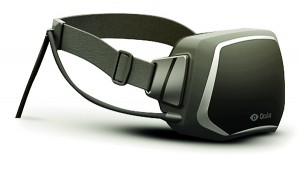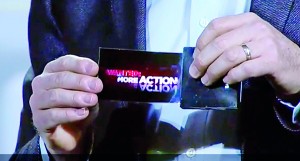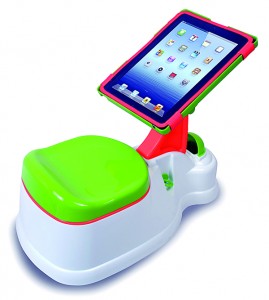World’s largest ultra high definition TV, smart refrigerator unveiled
View(s):International Consumer Electronics Show 2013 round-up
By Jagdish Hathiramani
The international Consumer Electronics Show, held annually in Las Vegas, USA, is typically the first opportunity of the New Year for big name TV, mobile phone, computer and gaming companies, amongst others, to get the world excited about upcoming new products and technologies as well as re-conceptualised and/or improved existing technologies. It is also a showcase for what can only be described as, for lack of a better term, the bizarre. In fact, some of the tech unveiled at this event is so bleeding-edge, in terms of innovation, that it is unlikely to be fully available to consumers for several more years. A good case in point are the holographic glasses technology first showcased at the 2012 event which are currently being developed for military applications.
And, all things considered, the 2013 Consumer Electronics Show, popularly known as CES, and held between January 8 and 11, was no different. Actually, it was larger this year. Not only were updated product ranges showcased for a variety of tablets, mobile phones and computer brands, as well as advancements in new tech shown last year. But, most importantly, there was also a string of completely new concepts, from tablet gaming consoles, to virtual reality gaming and even flexible screen technology soon to be used in a number of devices, etc. And the fantastical was also well represented, with a hybrid racing car, futuristic firearms, etc. In fact, there was no doubt that 2013 stood out in its own right in terms of innovation and creativity, and obviously size and scope, even when the products presented were sometimes less than overwhelming.

Oculus Rift Virtual Reality (VR) gaming system
Displays
Some of the biggest draws for crowds this year at CES related to displays. Not only were they audience favourites, but many were also well reviewed in terms of innovation and creativity.
Oculus Rift Virtual Reality (VR) gaming system
Coming right out of the gate, one of the most unique and well developed new product ranges at CES 2013 was Oculus’s take on a formerly defunct technology. Whereas VR had previously been banished to the realm of science fiction trivia, this new product brought it back to being relevant, especially considering the closeness, in terms of realism, that this new VR environment has achieved.
Described as a real, immersive, 3D stereo experience, which is still consumer priced, the new VR differs from the previously novelty type arcade version because it has already been accepted by the gaming industry in some form with hopes that this will soon translate into a number of games, etc. The development kit for this system is scheduled to ship in March 2013.
Samsung Youm
Another big step in display technology was debuted as top phone maker Samsung showcased a prototype device featuring its “Youm” flexible OLED (organic light- emitting diode) display. This flexible display purportedly makes devices virtually unbreakable, or, at the very least, unlikely to crack even after falls from great heights or similar damage.

Samsung showcasing its prototype device featuring its "Youm" flexible OLED (organic light- emitting diode) display.
Haier’s “TVs of the future” prototype
Unveiling a far-reaching concept for the future of TV, China’s Haier revealed its “TVs of the future” prototype at CES 2013. This prototype tracks eye movements and brainwaves to change the channel and carry out a number of other functions. Based on technology developed in conjunction with NeuroSky, this TV concept also offers voice and gesture controls to further augment the TV viewing experience.
Plastic Logic PaperTab
Similar to Samsung’s Youm flexible display technology, Plastic Logic revealed a Kindle-style e- reader called the PaperTab. This 10.7-inch Intel powered tablet PC is flexible, made of plastic and bends just like a real piece of paper. And most interestingly it is currently designed in a way that each PaperTab features just one app, instead of many, so multiple devices need to interact with each other wirelessly to share content, etc. This also allows multiple devices to come together to create larger screens.
110-inch HiSense XT900 4K TV
Continuing the tradition novel displays being unveiled at CES, HiSense unveiled the world’s largest ultra high definition TV, the XT900 4K TV. This 3,840 x 2,160 native resolution Ultra LED TV is currently lacking video content and proper pricing or release information, but it garnered a lot of interest at CES.
Philips 60-inch glasses-free 3D Ultra HD TV
While the talk of CES was undoubtedly OLED 4K TVs, with a number of soon-to-market products unveiled by several big name consumer electronics brands, 3D also made some, although significantly smaller inroads, at the exhibition. The best reviewed of these was the Philips 60-inch glasses-free 3D Ultra HD TV which allows users to be immersed in a 3D movie while being as close as 3.5 metres from the screen, and best of all; its glasses free.
LG Laser TV projector
Additionally showcased at CES 2013 was a new generation of “short throw” projectors which allow a 100 inches sized image projected from just 22 inches away. This Laser TV projector from Korea’s LG may one day become a viable alternative to current high-definition TVs, which are often just over 40 inches high. This is especially significant since apartment/office sizes will no longer be an issue for projectors due to the “short throw” innovation now becoming firmly rooted.
CTX VK200 Keyfob virtual laser keyboard
A device that has, as yet, failed to impress, but which is noteworthy because it is another step in the right direction for laser keyboards, the CTX VK200 Keyfob virtual wireless keyboard was also showcased at CES 2013. However glitchy it may have seemed to some (one reviewer even commented that it failed to work because they were wearing nail polish), this new technology appears to be on the cusp of consumer adoption.
Displair Airbourne Interactive Display
Another interesting application seen at CES 2013, but this time pertaining to holographic technology, was Displair’s airbourne interactive display. With the capability to project a 3D holographic image within a device that displaces ultra-fine vapour upwards. This product also offers multi-touch gesture capabilities. In fact, the Russian company behind this product is currently pitching it as a marketing novelty for exhibitions, promotions, etc.
Smart phones, tablets, laptops, gaming
There were a number of smart phones, tablets, laptops and gaming consoles showcased at CES 2013. While many just included upgrades from years past, others showed new horizons of creativity.
SonyXperia Z
At CES 2013, Sony unveiled its quad-core Xperia Z smartphone, which will be released to Japanese consumers this coming week, the first week of February. The key feature of this Android phone? Not just that it has 5.0-inch capacitive touch screen. Or a 13.1 megapixel camera. But that it is water proof.
Spare One Phone
Another device to debut at CES 2013 was the Spare One Phone. Priced at US$ 49, this phone is very basic in terms of features. In truth, it cannot be called a smart phone at all. But where it piques one’s interest is that it has 15 years power capacity and 10 hours talk time, all from a single “AA” size battery.
AMD Temash Tablet
Unique in that it is one of few tablets today offering AMD processors, the Temash uses Windows 8 and has a 1080p display. Offering up to 10 hours of battery life, the Temash has been particularly well reviewed for gaming.
OLPC 7-inch Android XO Tablet
A 7-inch Android tablet unveiled by the One Laptop per Child (OLPC) alliance, this tablet has one of the features that make it more interesting than compared to the ocean of tablets now on offer. It offers a hand crank whereby one minute of manual turning, by hand, translates into 10 minutes of battery life for this device. However, just like many other OLPC concepts, this prototype was not accompanied by a date for its availability or a price.
Panasonic 4K Tablet prototype
One tablet which stole the show at CES 2013 was the Panasonic 4K tablet prototype, which was well received primarily because of its very high screen resolution. Run on Windows 8, this tablet’s 4K display makes it a true “must see” experience despite price and availability being not on the books yet.
Asus Transformer P1801 Tablet
Moving away from the more typical tablets, Asus also showcased its all-in-one personal computer at CES this year, the Transformer P1801. However, not only is it an all-in-one desktop that runs both Android and Windows 8 but, similar to its Transformer tablet range, it has a detachable 18.5-inch multi-touch display with a separate battery which doubles as a rather large tablet.
Razer Edge Gaming Tablet
Another completely new interpretation of the tablet is its use in gaming, and one of the best examples of this being showcased at CES 2013 was the Razer Edge. A tablet built specifically for playing high-end PC games, this device offers a high-resolution display together with a Intel Core i5 processor, 4GB of RAM and a 64GB SSD. The introductory model will be priced at US$ 999.99.
Novelties
Aside from the more commonly desired consumer electronics, CES 2013 also showcased a number of unique concepts, some good and others bad, competing for attention from the massive audience.
iPotty
A badly received innovation at CES 2013 which is yet noteworthy for its new approach to an age old problem; the iPotty. A product that further integrates the iPad into the realm of toilet training for young children. Building on the demand for toilet training apps available at the Apple Store, this product, due out in March 2013, may never get any traction in terms of sales but will surely get a few people doing a “double take” due to its sheer novelty factor.

The iPotty, a product that further integrates the iPad into the realm of toilet training for young children.
HapiFork
Another novelty debuting at CES 2013, and mostly badly reviewed, the HapiFork works on the premise that a person eating too quickly could eventually suffer from obesity. As such, this US$ 99 product, created in France, offers up a simple solution, a fork that vibrates if one were to eat too quickly.
spnKiX Electric Skates
Advancing the lot of skating enthusiasts everywhere, Acton Inc unveiled its spnKiX battery-powered electric skates. Strapping onto one’s shoes, and controlled by a handheld remote, these hard-to-handle electric skates are being touted as being the world’s smallest electric vehicle.
Audi R18 e-tron quattro
Car maker Audi used CES 2013 to showcase its hybrid racing car concept, the R18 e-tron quattro. This Le Mans 24-hour race winner features, amongst other things, a motor generator unit (MGU) wherein energy is collected during braking. And then recycled into power for some of the vehicle’s other systems.
Meanwhile, inside the car’s cockpit, there is an OLED rearview mirror that displays high-resolution imagery that aids drivers in processing what’s going on at high speed.
Ford and General Motors Infotainment
Two of the world’s biggest car makers announced at CES that they would soon be opening their onboard infotainment systems to apps and content developed by third parties. This means that third party developers will soon likely have access to millions of vhicle owners through their vehicles’ dashboards, resulting in the possibility of another new platform and infrastructure to sell apps and other content.
Brother Dreamweaver XE Sewing Machine
Not to be outdone by new-fangled concepts such as 3D printing, one company at CES 2013 revealed a new take on an old school craft; sewing. The Brother Dreamweaver XE Sewing Machine offers a state-of-the-art 10-needle embroidery machine tied in with sharp, high-definition LCD touchscreen display for precision sewing purposes. For those interested, this wonder machine can quilt, sew and embroider amongst other things.
Qi wireless charging standard
Also on offer at CES 2013 was a number of wireless charging power sources at the Qi booth, possibly indicating a wider adoption of the Qi charging standard. Spearheaded by the Wireless Power Consortium, CES 2013 showcased improvements in this wireless charging technology, which could lead to charging across wider distances as well as charges built into furniture, etc.
Samsung T9000 smart refrigerator
In a nod to the ‘kitchen of the future’ concept, Samsung unveiled its latest smart refrigerator at CES 2013. The device, which includes an LCD screen and Evernote integration, allows users to search for recipes, etc., via its calendar function. Additionally, this is aside from being able to set the refrigerator to perform other handy tasks, like sharing grocery lists, managing food inventory, etc.
Tetherboard Tethercell
An extremely cool innovation spotlighted at CES 2013 was Tetherboard’s Tethercell Bluetooth battery case. The interesting thing about this product is that, when combined with an “AAA” battery, and placed inside a gadget using “AA” batteries, it can let the user remotely shut down the gadget in question via Bluetooth and a mobile phone app.
Bracketron Mushroom GreenZero Wall Travel Charger
Beyond just cutting edge technology, CES 2013 also featured a number of sustainable energy products. One of the most, best received was Bracketron’s Mushroom GreenZero Wall Travel Charger. This simple concept is, essentially, a portable charging device that stops using wall outlet electricity once the device’s battery is fully charged.
Logitech Wireless Solar Keyboard
Another simple sustainable energy idea presented at CES 2013 was Logitech’s new Wireless Solar Keyboard. This keyboard has a solar panel attached to it that allows recharging via workplace windows.
TrackingPoint self-aiming firearms
Finally, at a time when loose gun control rules are causing havoc amongst communities, there appeared to at least a glimmer of hope at CES 2013 when TrackingPoint unveiled self-aiming firearms technology. A key feature of which is built-in restrictions stopping firearms from targetting human beings.
Priced at a hefty US$ 20,000, TrackingPoint’s products are called as PGFs (Precision Guided Firearms), and utilise in-built processors to lock on to a target and compensate for distance, gravity, wind, etc.
Follow @timesonlinelk
comments powered by Disqus

















